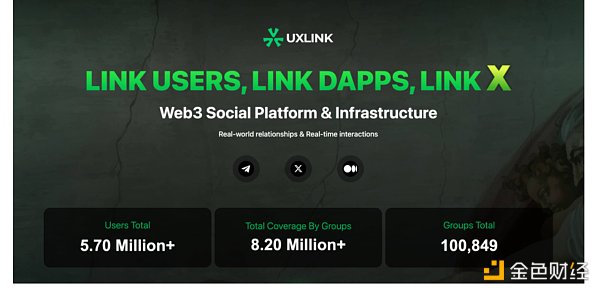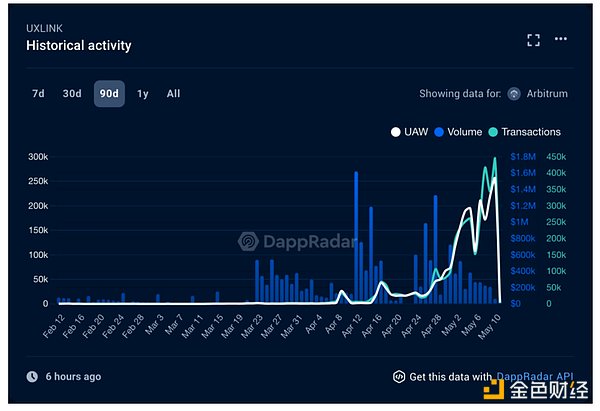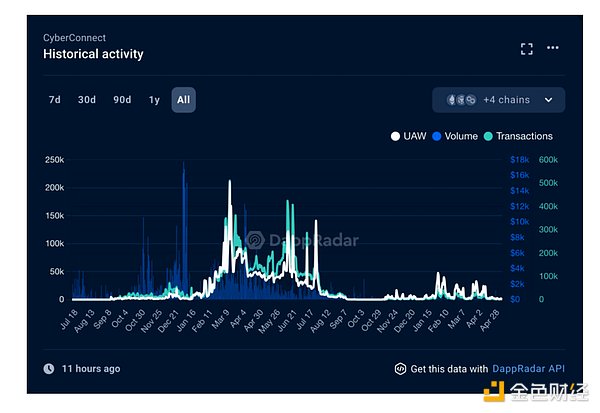Source: Web3CN
Backed by billions of social media users around the world, SocialFi is regarded as a new growth point in the Web3 era, attracting a large number of builders to invest in it, and has successively launched two popular products, Friend.tech and Farcaster. Recently, the SocialFi field has ushered in a new dark horse - UXLINK.
It is understood that UXLINK is a new SocialFi infrastructure project built on Telegram. Unlike Friend.tech and Farcaster, UXLINK mainly focuses on "acquaintance social networking", supporting users to build a real-world acquaintance social relationship map through Link-to-Earn and capture value. Since its launch in April 2023, UXLINK has over 5.7 million registered users, built over 100,000 group chats, and reached about 8.2 million people, becoming one of the world's largest Web3 social platforms.

Social products have always been hailed as one of the most popular tracks on the Internet. As a Web3 social newcomer, how did UXLINK gain user preference? This article will explore in depth.
In just over a year, UXLINK's development is impressive. According to relevant sources, UXLINK has more than 9,000,000 EOAs (Externally Owned Accounts) on the entire network, which is nearly 10 times that of Friend.Tech and about 30 times that of Farcaster. Dune data shows that as of press time, Friend.Tech has 914,454 unique addresses and Farcaster has 359,404 unique users.
In addition to the basic users, UXLINK's active user data (UAW, unique active wallets) is also not inferior. Data shows that Friend.Tech has been quiet since its popularity in August last year, with UAW falling from a peak of 80,000 to around 1,500[3], and 24-hour transactions at 2,800. Farcaster, which emphasizes social data ownership and cross-platform interaction, has shown a steady growth in daily active users, with a DAU of around 50,000[4], but its overall growth rate is slower than that of UXLINK. DappRadar data shows that UXLINK's UAW has started to grow rapidly since April this year, and currently the daily UAW is stable at around 250,000[5], with daily on-chain interactions (Transactions) of around 400,000.

It is not difficult to see that UXLINK has reached the level of top social projects in terms of user base and attention. What is more important is that UXLINK is built on Telegram, which has more than 800 million monthly active users, which means that it still has huge room for growth.
The eye-catching data performance also captured the favor of capital. According to public information on the Internet, in March this year, UXLINK received investment from a number of crypto VCs such as OKX Ventures and Matrixport Ventures, with a cumulative financing amount of more than 9 million US dollars. The day before the release, UXLINK announced that it had received a new round of financing led by SevenX Ventures, INCE Capital and HashKey Capital, with a financing amount of over 5 million US dollars. So far, UXLINK's total financing has exceeded 15 million US dollars, covering many first-line institutions and well-known individuals from Europe, America, Asia and the Middle East.
With the first quarter of UXLINK's airdrop activities underway and the approaching TGE, the asset performance of UXLINK after its launch has also become the most concerned issue in the community. The most common prediction for UXLINK's valuation is about 200 million US dollars. Compared with its data and valuations with Friend.tech and Farcaster, this data is not aimless.
According to public information on the Internet, CyberConnect, also a social infrastructure, has raised a total of $25 million ($10 million in November 2021 and $15 million in May 2022), with a total number of users of about 125,000[6], a UAW peak of 210,000[7], and a current market value of $168.57M (at the time of writing); Farcaster disclosed that it raised $30 million, and its valuation in the last round of financing reached $1 billion. With the arrival of the second half of the bull market, the valuation of the SocialFi project will also see further improvement. Industry insiders said that UXLINK may have a higher expected return after TGE.

The success of data is inseparable from outstanding product support. In order to support the development of the UXLINK ecosystem in different application scenarios and promote the large-scale adoption of Web3, UXLINK's three-layer architecture design is respectively oriented to the application layer, protocol layer and infrastructure layer, aiming to become the social relationship data infrastructure of the Web3 industry. The community asset penetration path of decentralized applications + community interaction + dual-currency economic model (utility token $UXUY and governance token $UXLINK) not only maximizes the ability of community assets to capture value, but also enables assets to have intrinsic value that is not dependent on liquidity, while supporting the value of native assets and achieving continuous hematopoiesis.
The native utility token $UXUY mainly serves as the core incentive for the development of the UXLINK community and ecosystem. It is not pre-minted and users can earn it by inviting others or contributing to the ecosystem. This also means that the earlier you create a social network, the more $UXUY you will get. The governance token $UXLINK is mainly used for community governance and to obtain income from UXLINK projects and products. It is worth noting that there is no lock-up period for the airdrop of governance tokens, while the governance tokens held by partners and teams will have a lock-up period of 3-6 months and follow the rule of 2-year linear quarterly release to encourage long-term participation. This move also reflects UXLINK's determination to deepen its long-term development in the SocialFi track.
For a long time, Web3 social has been seeking a balance in the Social + Fi model, and driven by Crypto consensus, the relationship between social and assets is also evolving. The emergence of UXLINK has undoubtedly brought a new perspective to the SocialFi track. Standing on the shoulders of Web2 social giants, UXLINK cleverly imports Web2 traffic into Web3, and uses its unique ecosystem advantages such as DeFi, NFT, and GameF in Web3 to build a unique and innovative social infrastructure for users that integrates products, users, and developers. With the launch of the project airdrop and the landing of multiple milestones, UXLINK may achieve outstanding performance.
 Alex
Alex
 Alex
Alex JinseFinance
JinseFinance JinseFinance
JinseFinance JinseFinance
JinseFinance Catherine
Catherine Beincrypto
Beincrypto Beincrypto
Beincrypto Beincrypto
Beincrypto Bitcoinist
Bitcoinist Nulltx
Nulltx